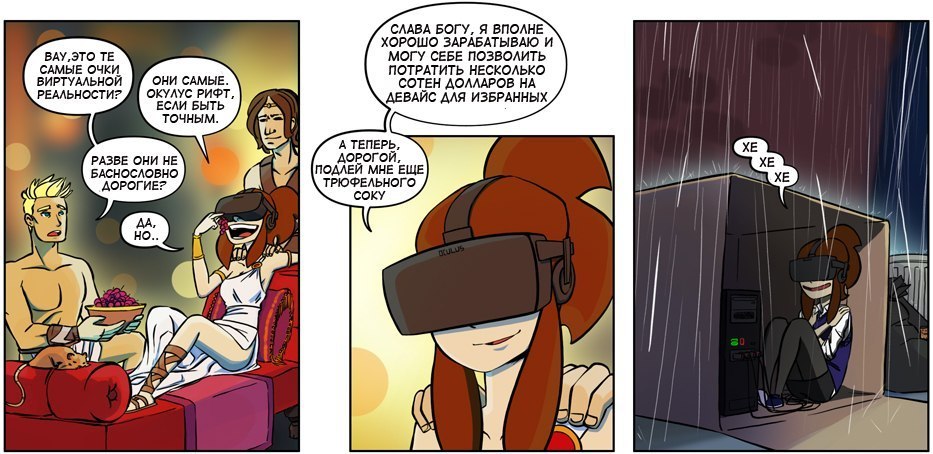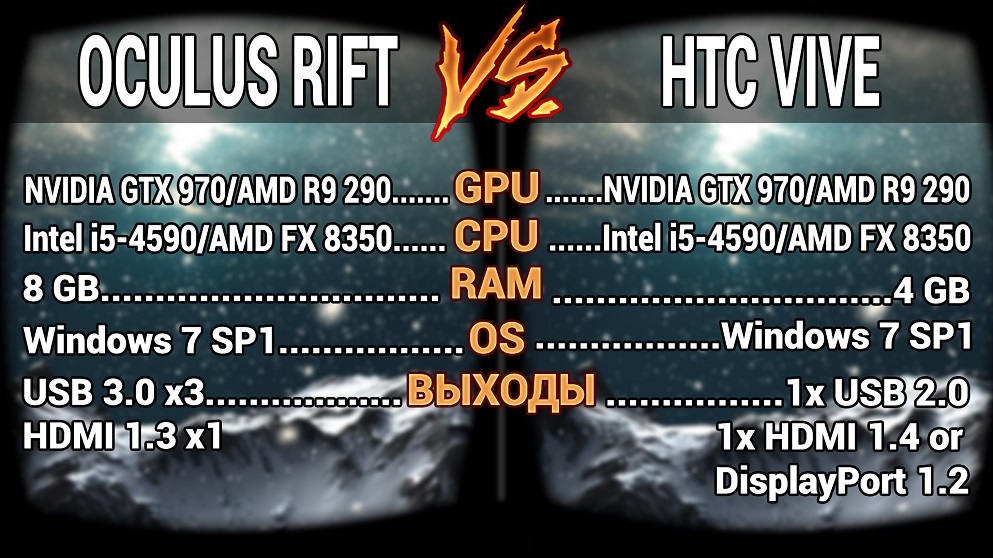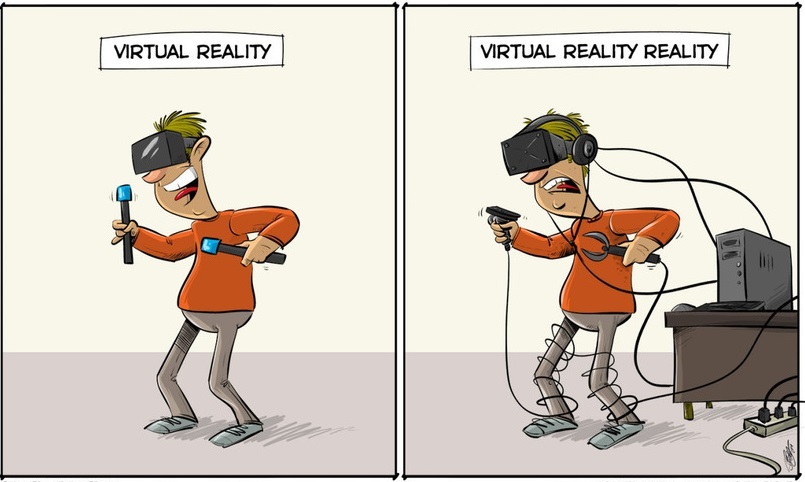4 virtual reality helmets that you can buy now
In the article you will find a comparative analysis of four popular virtual reality helmets that you can buy and try now: HTC Vive , Oculus Rift , Samsung Gear VR and Google Cardboard . We prepared this review with Maxim Chizhov, co-founder of the virtual reality club Virtuality Club . We did this on the eve of the launch of a new course in the framework of educational programs on the game industry at the VSBI - “ VR Development Methodology” . Training will begin in October, and those who wish to take shape need to have now, since the number of places is limited. This educational program will be taught to create gaming content for virtual reality helmets, but in today's article we will tell in detail about these same helmets.

Virtual reality is one of the most popular technologies of 2016. We already see its visual application, and in the future we are waiting for even more interesting! What can we say about the helmets of virtual reality, which is becoming more and more. After so many years of waiting, the Oculus Rift has finally arrived at its happy owners. At the same time, it is possible to buy a more affordable mobile virtual reality helmet - Samsung Gear VR . And, of course, let's not forget about the most expensive PC helmet with cool HTC Vive controllers and the most budgetary virtual reality glasses Google Cardboard . These gadgets were created for different target audiences, but we hope that it will be interesting for everyone to compare them and learn the strengths and weaknesses of each.
So, let's take a look at the wallet and see how much money an ordinary user will have to pay for flagship devices. HTC Vive comes first and its record $ 799 for the helmet , but it’s worth the credit that controllers are also included in this price. Next is the Oculus Rift with a bar just below - $ 599 . After them, Samsung Gear VR and $ 99.99 request for your mobile VR-helmet (but there are discounts and promotions and can be bought cheaper), and closes the Google Cardboard four with its record low price ($ 9 (V1.0) / $ 14.99 (V2. 0) + mount ($ 2) per set .
')

We turn to the analysis of system requirements. HTC Vive can only be overclocked on good hardware , it will need an NVIDIA GeForce GTX 970 or AMD Radeon R9 290 or higher, Intel i5-4590 or AMD FX 8350 and higher, 4GB RAM or more, HDMI 1.4 or DisplayPort 1.2 or newer, USB port 2.0 or higher, Windows 7 SP1, which will cost about $ 1000 .
Next in line is the Oculus Rift , which is not far from its direct competitor. The helmet will work stably on NVIDIA GTX 970 / AMD R9 290 or higher, Intel i5-4590 or higher, 8GB RAM or more, HDMI 1.3 compatible output, 3 USB 3.0 ports and 1 USB 2.0 port, Windows 7 Sp1 64 bit or newer. The approximate cost of a PC with these characteristics is also about $ 1000 . So you are lucky if you want one of these helmets and you already own a powerful PC, otherwise it may cost you more money to buy a new one or upgrade an old iron than the helmet itself.
Now on mobile VR: everything is somewhat simpler here, because the base for gadgets is a smartphone. Samsung Gear VR is compatible with its own line: Galaxy S7, Galaxy S7 Edge, Galaxy Note 5, Galaxy S6 Edge +, Galaxy S6, Galaxy S6 Edge, prices range from $ 629 - $ 800 . As for Google Cardboard , the device will work with any smartphone on Android OS 4.1 and higher, or on iPhone 4/5/6.

Of course, the amount of content in app stores is one of the important factors influencing the decision in favor of buying a particular device. The number of software and games in the Oculus store is approaching the mark of 200 units, but on Steam VR for HTC Vive there are already more than 400 VR applications. But of course, in the budget segment of Google Cardboard, the abundance of applications is maximum - with it all mobile VR applications go.

It is still difficult to talk about design in the field of VR, as there are no established norms yet. Specifically, the appearance of the HTC Vive and Oculus Rift attracts the attention of futuristic. These two helmets are not similar to each other, but each of them has its own “zest”. Rift looks strictly and minimalist, which gives it a certain elegance. In turn, Vive boasts an extraterrestrial design mentally sending us to the films about the aliens. Both helmets look spectacular and expensive, which corresponds to their price.
The following are Samsung Gear VR and Google Cardboard. Gear VR looks very nice and stylish, has high-quality plastic in white and gray colors, which is pleasant not only to look, but also to the skin during use. The Cardboard has a hard cardboard case. But, considering what the developers want for it, you should not pay attention to it. Moreover, the cardboard is not very unpleasant to the skin and has no sharp corners, which allows it to be used in the same way as the Gear VR, without serious inconvenience.

And here everything becomes more interesting. Oculus Rift and HTC Vive have two built-in OLED-displays with a resolution of 2160x1200 pixels. And let Gear VR not be far behind here, you need to understand that smartphone software cannot always compare to the quality of graphics with a PC. But the difference between the HTC Vive and the Oculus Rift is almost imperceptible - it all comes down to the content developed specifically for a particular helmet, taking into account the features of its use. The performance of Google Cardboard is completely dependent on the smartphone itself.

PC helmets HTC Vive and Oculus Rift are not inferior to each other in terms of functionality or design, and their price range is about the same. The essential difference between the brainchild of HTC Vive and the development of Palmer Lucky - the first helmet immediately at the start of sales allows the player to interact with objects through controllers, and the second is only ready to release Oculus Touch controllers.
For mobile VR, portability and price are still important. Google Cardboard is focused primarily on getting to know the world of virtual reality, while Samsung Gear VR is more suitable for active use. In October 2016, a console virtual reality helmet from Sony PSVR is also coming out and it plans to outperform its competitors in terms of price / quality ratio. It still can not be tried in open access, so it remains only to believe the optimistic forecasts of analysts. By the way, their forecast for 2016 by the number of items sold.
Well, now decide for yourself what kind of helmet is right for you, and join the world of virtual reality!

Virtual reality is one of the most popular technologies of 2016. We already see its visual application, and in the future we are waiting for even more interesting! What can we say about the helmets of virtual reality, which is becoming more and more. After so many years of waiting, the Oculus Rift has finally arrived at its happy owners. At the same time, it is possible to buy a more affordable mobile virtual reality helmet - Samsung Gear VR . And, of course, let's not forget about the most expensive PC helmet with cool HTC Vive controllers and the most budgetary virtual reality glasses Google Cardboard . These gadgets were created for different target audiences, but we hope that it will be interesting for everyone to compare them and learn the strengths and weaknesses of each.
Price
So, let's take a look at the wallet and see how much money an ordinary user will have to pay for flagship devices. HTC Vive comes first and its record $ 799 for the helmet , but it’s worth the credit that controllers are also included in this price. Next is the Oculus Rift with a bar just below - $ 599 . After them, Samsung Gear VR and $ 99.99 request for your mobile VR-helmet (but there are discounts and promotions and can be bought cheaper), and closes the Google Cardboard four with its record low price ($ 9 (V1.0) / $ 14.99 (V2. 0) + mount ($ 2) per set .
')

System requirements
We turn to the analysis of system requirements. HTC Vive can only be overclocked on good hardware , it will need an NVIDIA GeForce GTX 970 or AMD Radeon R9 290 or higher, Intel i5-4590 or AMD FX 8350 and higher, 4GB RAM or more, HDMI 1.4 or DisplayPort 1.2 or newer, USB port 2.0 or higher, Windows 7 SP1, which will cost about $ 1000 .
Next in line is the Oculus Rift , which is not far from its direct competitor. The helmet will work stably on NVIDIA GTX 970 / AMD R9 290 or higher, Intel i5-4590 or higher, 8GB RAM or more, HDMI 1.3 compatible output, 3 USB 3.0 ports and 1 USB 2.0 port, Windows 7 Sp1 64 bit or newer. The approximate cost of a PC with these characteristics is also about $ 1000 . So you are lucky if you want one of these helmets and you already own a powerful PC, otherwise it may cost you more money to buy a new one or upgrade an old iron than the helmet itself.
Now on mobile VR: everything is somewhat simpler here, because the base for gadgets is a smartphone. Samsung Gear VR is compatible with its own line: Galaxy S7, Galaxy S7 Edge, Galaxy Note 5, Galaxy S6 Edge +, Galaxy S6, Galaxy S6 Edge, prices range from $ 629 - $ 800 . As for Google Cardboard , the device will work with any smartphone on Android OS 4.1 and higher, or on iPhone 4/5/6.

The next burning question: “What to play?”
Of course, the amount of content in app stores is one of the important factors influencing the decision in favor of buying a particular device. The number of software and games in the Oculus store is approaching the mark of 200 units, but on Steam VR for HTC Vive there are already more than 400 VR applications. But of course, in the budget segment of Google Cardboard, the abundance of applications is maximum - with it all mobile VR applications go.

Design
It is still difficult to talk about design in the field of VR, as there are no established norms yet. Specifically, the appearance of the HTC Vive and Oculus Rift attracts the attention of futuristic. These two helmets are not similar to each other, but each of them has its own “zest”. Rift looks strictly and minimalist, which gives it a certain elegance. In turn, Vive boasts an extraterrestrial design mentally sending us to the films about the aliens. Both helmets look spectacular and expensive, which corresponds to their price.
The following are Samsung Gear VR and Google Cardboard. Gear VR looks very nice and stylish, has high-quality plastic in white and gray colors, which is pleasant not only to look, but also to the skin during use. The Cardboard has a hard cardboard case. But, considering what the developers want for it, you should not pay attention to it. Moreover, the cardboard is not very unpleasant to the skin and has no sharp corners, which allows it to be used in the same way as the Gear VR, without serious inconvenience.

Performance
And here everything becomes more interesting. Oculus Rift and HTC Vive have two built-in OLED-displays with a resolution of 2160x1200 pixels. And let Gear VR not be far behind here, you need to understand that smartphone software cannot always compare to the quality of graphics with a PC. But the difference between the HTC Vive and the Oculus Rift is almost imperceptible - it all comes down to the content developed specifically for a particular helmet, taking into account the features of its use. The performance of Google Cardboard is completely dependent on the smartphone itself.

Advantages and disadvantages
| . | pros | Minuses |
| one | Oculus can be called a really high-quality product, which has decent performance, comfortable form, with a good bundle. Game graphics at a height, especially in comparison with the developer version of the helmet DK2. The high speed of updating without delay allows you to immerse yourself in the gameplay and sometimes even forget that you are physically in the real world. | Of the minuses, we note that for many budget PCs this helmet will be too tough. The device requires great performance from the computer. Moreover, interaction with objects in games is performed using an Xbox controller, and the player really wants to touch and poke everything on their own! It is also worth considering that at the moment almost all games in Oculus Rift will have to be played while seated. |
| 2 | The great advantage of HTC Vive is the ability to “go away with your hands” into a different reality, allowing the user to contact objects with the help of two controllers. What could be better than tactile activity? Also, thanks to an advanced system of monitoring human actions, the helmet allows you to move in the game "independently", physically moving through the real room without the help of a gamepad. Full immersion is enhanced by the possibility of physical movement in a given area. The minimum area required for installing tracking sensors is 1.5x2 meters, and the placement height is 2 meters. The maximum allowable distance between the sensor is 5 meters. | As is the case with competitors HTC, the player will need hard iron in order to enjoy the miracle of engineering. And the presence of wires can make you think about how to get lost in them while moving, and not about what happens in the game. Everything else for a comfortable game in the helmet requires a sufficiently large free area and the ability to hang the camera on the sides of the playing area. HTC Vive is currently the most expensive helmet, and besides, it is rather complicated to set up. |
| 3 | Price and portability are key benefits of the Samsung Gear VR . Unlike the Oculus Rift and the HTC Vive, it is much more accessible and gives decent game performance. The user is not chained to the computer and can use the device where it is convenient for him. The absence of cords is a big plus. | The phone’s resources are limited and cannot be compared with the performance of a cool PC, so you shouldn’t expect the same dive like from pc-helmets. Games on Gear VR sometimes slow down, and the quality of games on Gear VR is mostly inferior to games on Oculus Rift and HTC Vive. |
| four | The advantage of Google Cardboard points, in addition to the low price, is compatibility with most devices, including the iPhone. Quality, respectively, depends on the smartphone. Google Cardboard is not a final product, but a set of charts and drawings from Google, using which anyone can collect their own virtual reality glasses. For this you need a pair of lenses, a piece of cardboard and a little ingenuity. | The disadvantages of glasses are the lack of softening nozzles and a strap for fixing on the head, the poor quality of the device as a whole. |
findings
PC helmets HTC Vive and Oculus Rift are not inferior to each other in terms of functionality or design, and their price range is about the same. The essential difference between the brainchild of HTC Vive and the development of Palmer Lucky - the first helmet immediately at the start of sales allows the player to interact with objects through controllers, and the second is only ready to release Oculus Touch controllers.
For mobile VR, portability and price are still important. Google Cardboard is focused primarily on getting to know the world of virtual reality, while Samsung Gear VR is more suitable for active use. In October 2016, a console virtual reality helmet from Sony PSVR is also coming out and it plans to outperform its competitors in terms of price / quality ratio. It still can not be tried in open access, so it remains only to believe the optimistic forecasts of analysts. By the way, their forecast for 2016 by the number of items sold.
| Google cardboard | Gear vr | Oculus + vive | Sony VR | |
| Superdata | 27 million | 3.5 million | 0.7 + 0.4 million | 2.6 million |
| Piper jaffray | - | 5 million | 3.6 + 2.1 million | 1.4 million |
Well, now decide for yourself what kind of helmet is right for you, and join the world of virtual reality!
Source: https://habr.com/ru/post/307112/
All Articles